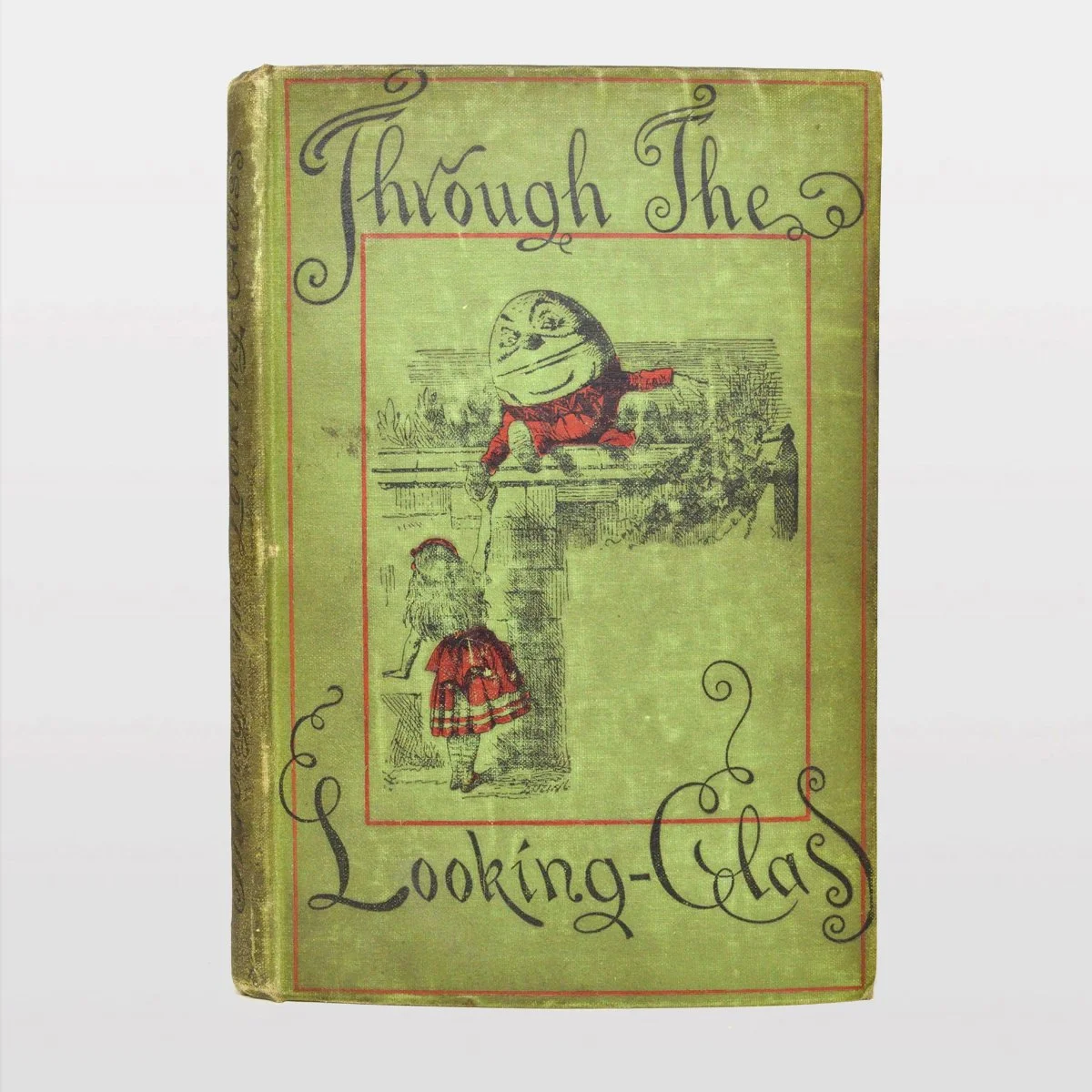 Image 1 of 2
Image 1 of 2

 Image 2 of 2
Image 2 of 2



Through the Looking-Glass. CARROLL (Lewis).
EDMUND WILLIAM GOSSE'S COPY
Through the Looking-Glass And What Alice Found There.
With fifty illustrations and frontispiece by John Tenniel.
"People's Edition". 8vo. [187 x 130 x 18 mm]. [v]ff, 208, [2] pp. Bound in the publisher's original green cloth, covers illustrated in red and black, spine lettered in black, plain endleaves. (Slight lean to the binding, spine rubbed and darkened, slight bump to edges). Macmillan and Co., 1887
Tissue guard to frontispiece is slightly browned, the odd trivial mark in the text, otherwise internally very good.
With the bookplate of Edmund William Gosse, designed by the American artist Edwin A. Abbey. In his Gossip in a Library (1891) Gosse makes the case for the usefulness of bookplates: "There are many good bibliophiles who abide in the trenches, and never proclaim their loyalty by a book-plate. They are with us yet not of us …. Such a man is liable to great temptations. He is brought face to face with that enemy of his species, the borrower, and dares not speak with him in the gate. If he had a book-plate he would say, "Oh! certainly I will lend you this volume, if it has not my book-plate in it; of course, one makes it a rule never to lend a book that has".
Sir Edmund William Gosse (1849-1928) was the son of the renowned English naturalist Philip Henry Gosse (1810-1888), a prolific author and populariser of natural sciences. According to Wertheimer in his biography of Philip Gosse he was the 'Father of the Aquarium'. He was also one of the chief figures among the Brethren, a evangelical Christian group within Britain. Edmund was heavily influenced by his religious upbringing, breaking away from his faith and writing an account of his childhood in Father and Son, first published in 1907. It has been described as the first psychological biography and focuses on the relationship between a stern religious father and his son's gradual rejection of Christian fundamentalism.
Edmund Gosse was also a renowned literary critic and poet, and he became acquainted with the likes of Hans Christian Anderson and Alfred Lord Tennyson and became friends with Robert Browning, Algernon Charles Swinburne, Thomas Hardy and Henry James. Gosse lectured in English literature at Trinity College, Cambridge from 1884-1890 and became an important art critic dealing with sculptures, leading to his close friendship with Hamo Thornycroft, whose nephew Siegfried Sassoon found a formative influence in Gosse. From 1904-1914 he was the librarian of the House of Lords, in 1912 he was named a Companion of the Order of Bath and in 1925 was knighted.
Stock no. ebc8763
EDMUND WILLIAM GOSSE'S COPY
Through the Looking-Glass And What Alice Found There.
With fifty illustrations and frontispiece by John Tenniel.
"People's Edition". 8vo. [187 x 130 x 18 mm]. [v]ff, 208, [2] pp. Bound in the publisher's original green cloth, covers illustrated in red and black, spine lettered in black, plain endleaves. (Slight lean to the binding, spine rubbed and darkened, slight bump to edges). Macmillan and Co., 1887
Tissue guard to frontispiece is slightly browned, the odd trivial mark in the text, otherwise internally very good.
With the bookplate of Edmund William Gosse, designed by the American artist Edwin A. Abbey. In his Gossip in a Library (1891) Gosse makes the case for the usefulness of bookplates: "There are many good bibliophiles who abide in the trenches, and never proclaim their loyalty by a book-plate. They are with us yet not of us …. Such a man is liable to great temptations. He is brought face to face with that enemy of his species, the borrower, and dares not speak with him in the gate. If he had a book-plate he would say, "Oh! certainly I will lend you this volume, if it has not my book-plate in it; of course, one makes it a rule never to lend a book that has".
Sir Edmund William Gosse (1849-1928) was the son of the renowned English naturalist Philip Henry Gosse (1810-1888), a prolific author and populariser of natural sciences. According to Wertheimer in his biography of Philip Gosse he was the 'Father of the Aquarium'. He was also one of the chief figures among the Brethren, a evangelical Christian group within Britain. Edmund was heavily influenced by his religious upbringing, breaking away from his faith and writing an account of his childhood in Father and Son, first published in 1907. It has been described as the first psychological biography and focuses on the relationship between a stern religious father and his son's gradual rejection of Christian fundamentalism.
Edmund Gosse was also a renowned literary critic and poet, and he became acquainted with the likes of Hans Christian Anderson and Alfred Lord Tennyson and became friends with Robert Browning, Algernon Charles Swinburne, Thomas Hardy and Henry James. Gosse lectured in English literature at Trinity College, Cambridge from 1884-1890 and became an important art critic dealing with sculptures, leading to his close friendship with Hamo Thornycroft, whose nephew Siegfried Sassoon found a formative influence in Gosse. From 1904-1914 he was the librarian of the House of Lords, in 1912 he was named a Companion of the Order of Bath and in 1925 was knighted.
Stock no. ebc8763
